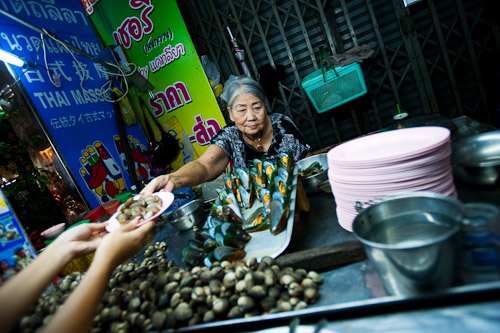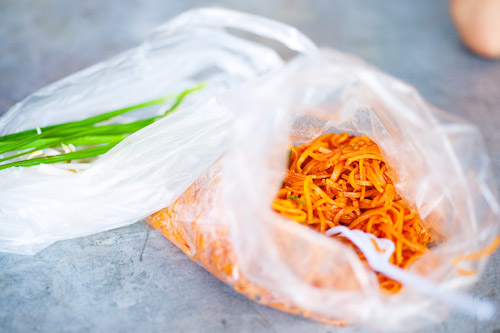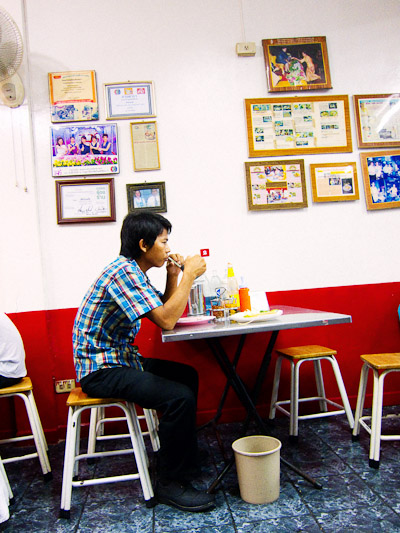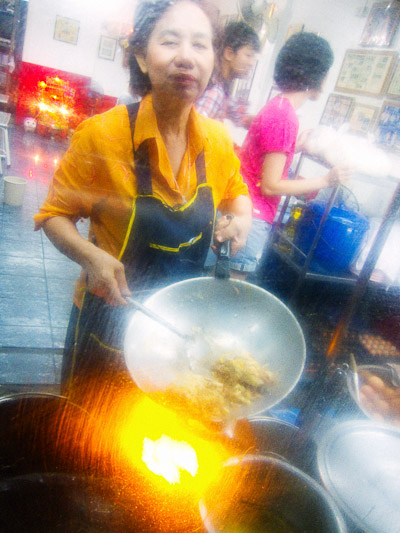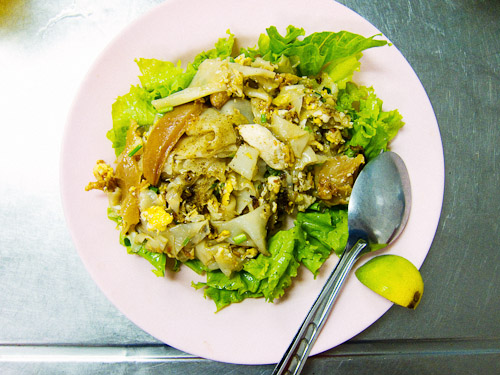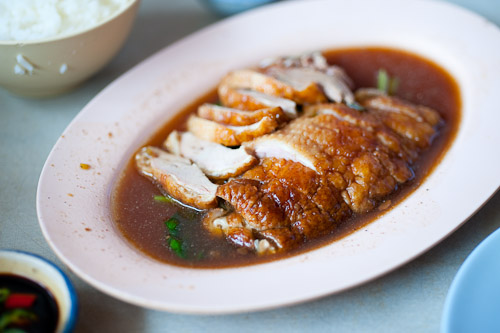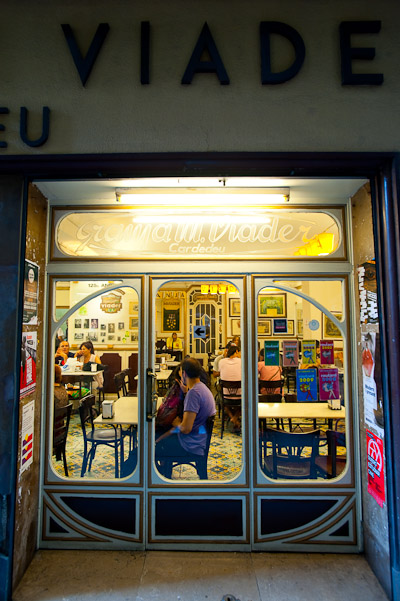Vendor selling sexual aids, Bangkok’s Chinatown
From “The Last Chinatown”, Kathmandu Photo Gallery, 2008/2009
DSC4814
In a market in Bangkok’s Chinatown
From “The Last Chinatown”, Kathmandu Photo Gallery, 2008/2009
DSC0973
Man eating a streetside curry stall, Chinatown, Bangkok
From “The Last Chinatown”, Kathmandu Photo Gallery, 2008/2009
DSC8755
Woman in front of gold shop, Chinatown, Bangkok
From “The Last Chinatown”, Kathmandu Photo Gallery, 2008/2009
DSC3405
Man napping in front of a Chinese coffin, Chinatown, Bangkok
From “The Last Chinatown”, Kathmandu Photo Gallery, 2008/2009
All apologies
 as lately I just haven't had the time to do any new posts. To tide you over until my next blog, be sure to check out the series I've been doing at CNNGo's Bangkok pages, The Best Thai Dish You've Never Heard Of. This week's post is on mee phat krachet, thin rice noodles fried with water mimosa (pictured above). Go here for links to other pieces I've done on other obscure Thai dishes including kuaytiaw khua kai, khao khluk kapi and suki haeng.
as lately I just haven't had the time to do any new posts. To tide you over until my next blog, be sure to check out the series I've been doing at CNNGo's Bangkok pages, The Best Thai Dish You've Never Heard Of. This week's post is on mee phat krachet, thin rice noodles fried with water mimosa (pictured above). Go here for links to other pieces I've done on other obscure Thai dishes including kuaytiaw khua kai, khao khluk kapi and suki haeng.
Pa Jin/ป้าจิน
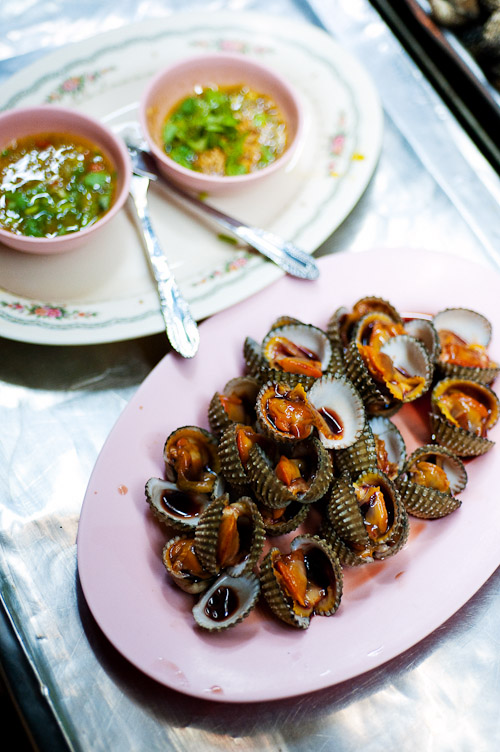 For the last 30 years, Pa Jin has been selling cooked cockles and mussels from a stall on a busy street in the centre of Bangkok's Chinatown.
For the last 30 years, Pa Jin has been selling cooked cockles and mussels from a stall on a busy street in the centre of Bangkok's Chinatown.
The relatively expensive price of 100B (about US$3) per plate belies the fact that you're sitting on a stool sucking car exhaust, but her unique cooking technique and good-quality raw ingredients make it worth it.
Rather than steam them, Pa Jin dips the cockles into a medium-sized pot of boiling water until they're just about to open - probably no more than 15 seconds. She then meticulously pries each one open by hand. The barely-cooked meat that emerges is tender and velvety, lacking the rubberiness of overcooked shellfish. The mussels, which have been pre-boiled, are also pretty good, and to order are briefly submerged in the same water.
Both are served with three kinds of dipping sauces (one order of dipping sauce is 'single', two is 'in love' and three is 'family') that run the gamut from tart/spicy to sweet.
And of course, Pa Jin has a website and a 'Call Center', the latter ostensibly for urgent cockle-related issues and/or emergencies.
Pa Jin Th Phadung Dao, Bangkok 081 795 1839 6.30pm-midnight
View Thai Eats in a larger map
Tang Ngee Huat/ตั้งหงีฮวด
 Khao tom (ข้าวต้ม), rice soup, typically supplemented with some sort of fancy protein, is a dish that Chinese Thais take very seriously. Folks will pay the equivalent of US$9 for a bowl of the stuff, and vendors selling the dish are found just about everywhere in Bangkok's Chinatown. Despite its fame, there are a lot of mediocre bowls out there, but thanks to my friend Y (who also led me to Sisamorn), I was pointed in the direction of one of the better ones.
Khao tom (ข้าวต้ม), rice soup, typically supplemented with some sort of fancy protein, is a dish that Chinese Thais take very seriously. Folks will pay the equivalent of US$9 for a bowl of the stuff, and vendors selling the dish are found just about everywhere in Bangkok's Chinatown. Despite its fame, there are a lot of mediocre bowls out there, but thanks to my friend Y (who also led me to Sisamorn), I was pointed in the direction of one of the better ones.
The entire kitchen at Tang Ngee Huat, a Chinatown shophouse restaurant, is little more than a small countertop:
This is where they assemble two versions of the dish: khao tom pet, rice soup served with duck, and khao tom kaphoh muu, with pig stomach. The owners claim that the restaurant has been serving these dishes for 63 years, following a Teochew recipe brought to Thailand by the previous generation.
Unlike most versions of the dish, which set out to impress with generous portions of fresh seafood, the star here is the broth. It's pleasantly salty and slightly peppery, with just enough deep-fried garlic so you know it's there, and satisfyingly crunchy bits of preserved vegetable. The bowl shown above is khao tom ruam, which includes duck, duck blood and pig stomach. The meat is minimal but exceedingly tender, and the odd combination somehow works.
Tang Ngee Huat 49 Th Plaeng Nam, Bangkok 02 227 6457 10am-9pm
View Thai Eats in a larger map
Sisamorn Lert Rot/ศรีสมรเลิศรส
 Khao kai op (ข้าวไก่อบ; shown above) is a dish of slices of marinated chicken served over rice. Si Samorn Lert Rot, a restaurant just off Th Convent in Bangkok's Silom area, claim to have been serving the dish for 50 years - an allegation seemingly backed up by their cool old-school sign:
Khao kai op (ข้าวไก่อบ; shown above) is a dish of slices of marinated chicken served over rice. Si Samorn Lert Rot, a restaurant just off Th Convent in Bangkok's Silom area, claim to have been serving the dish for 50 years - an allegation seemingly backed up by their cool old-school sign:
"Op" literally means to bake, but when I asked about their oven, the woman preparing the dish at Si Samorn replied that the meat was in fact deep-fried. "I don't know why they call it that," she added. Regardless, the chicken is expertly "baked" in a wok of hot oil until tender and moist. It's then sliced and served over rice and topped with a rich, oily and extremely garlicky sauce. It's a simple, satisfying dish, and this is allegedly one of the more famous places in Bangkok to eat it.
The meat is also available over noodles. I had the pork - also deep-fried, and also well-seasoned and tender - with thin rice noodles and a dollop of the previously-mentioned sauce:
Good, but it didn't quite come together as well as the rice version.
Highly recommended.
Si Samorn Lert Rot Soi Phiphat 2, Bangkok 6.30am-3pm Mon-Sat
View Thai Eats in a larger map
How to make: Kuaytiaw phat puu/ก๋วยเตี๋ยวผัดปู
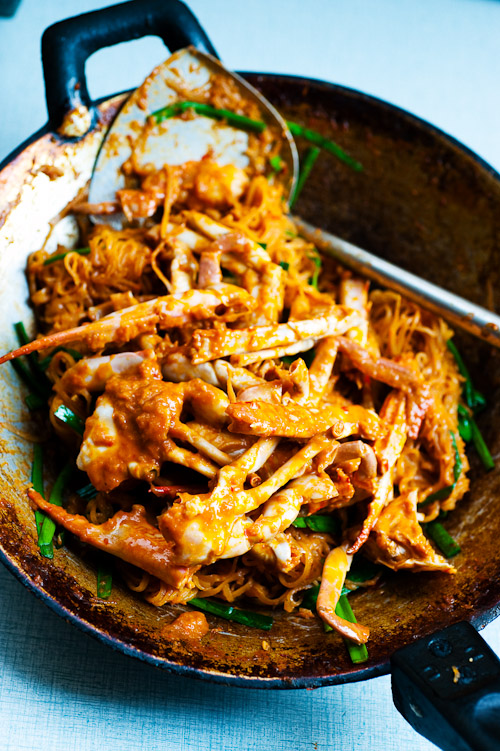 Kuaytiaw phat puu, rice noodles fried with a curry paste mixture and crab, is a signature dish of Chanthaburi. Despite this, it's only available at a couple places in the town, most of which are take-away only.
Kuaytiaw phat puu, rice noodles fried with a curry paste mixture and crab, is a signature dish of Chanthaburi. Despite this, it's only available at a couple places in the town, most of which are take-away only.
It took a bit of sleuthing, but I was eventually able to locate a lone stall in the city's market, and bought a bag:
Eating the noodles at a roadside coffee stall, I found them rich and slightly sweet, trailed by a barely-there spiciness. I liked the dish, and thought it had the added benefit of being easy to make for those who don't have access to obscure Thai ingredients. In searching the internet, I found two alternate versions of the recipe: one in which the crabs and then the curry paste are fried in oil before adding the noodles, and another in which the curry paste and crabs are simmered in coconut cream. I decided to go with the latter. If you can read Thai, the recipe upon which this is based can be seen here (the Thai script can't be viewed in Firefox for some reason). If you want to keep it authentic, try to find the famous sen chan, rice noodles from Chanthaburi, otherwise any thin rice noodles will do.
Kuaytiaw Phat Puu (Chanthaburi-style fried noodles with crab)
Large dried chilies, six, soaked in warm water until soft Shallots, 5, peeled Garlic, 6 large cloves, peeled Shrimp paste, about 2 Tbsp
Coconut cream, about 2 cups Dried thin rice noodles, 250g Tamarind paste, to taste Fish sauce and/or salt, to taste Palm sugar, to taste Ketchup, to taste Four swimmer crabs (about 750g), prepared and quartered Chinese chives, 1 small bunch, chopped into lengths of about 3cm
Lime, sliced Chinese chives, 2 small bunches Bean sprouts, about 1 cup Baby cucumber, four, sliced thinly
Make a curry paste by grinding chilies, shallots, garlic and shrimp paste in a mortar and pestle until fine. Set aside.
Bring coconut milk to a simmer a wok over med-low heat. Add curry paste, stirring to combine. Lower heat slightly, being careful not to allow coconut cream to boil, and simmer until liquid is reduced slightly and mixture is well-combined and fragrant, about 10 to 15 minutes.
While mixture is simmering, soak noodles in water until soft and flexible, about 10 minutes.
Season coconut cream mixture to taste with tamarind paste, fish sauce, sugar and ketchup; it should be somewhat sweet and sour, slightly less salty and spicy. Allow to simmer another 10 minutes or so until the flavours have combined. Add crab and simmer until cooked, another 5 minutes.
Pour mixture, including crab, into a large bowl. Return about 3/4 cup of the liquid back to the wok, followed by about 1/3 of the noodles. Fry, stirring to combine, adding water, if necessary, to prevent the noodles from sticking. The noodles can get pretty gloopy at this point; to avoid this, simply fry smaller portions. When noodles are soft and have absorbed the liquid, add 1/3 of chopped chives 1/3 of crab, stir to combine and serve, accompanied by a slice of lime, a couple stalks of Chinese chive, bean sprouts and sliced cucumber.
48 Hours in Chanthaburi
Little-visited Chanthaburi, located about 250km east of Bangkok, is yet another seriously underrated Thai food destination. The province is seemingly blessed with just about everything that's great about Thai cuisine: amazing fruit (some of Thailand's most sought-after durian are grown here), fresh seafood (particularly crabs) and rice (much of which is made into sen jan, the province's famous rice noodles). I was particularly interested in the local dishes that take advantage of Chanthaburi's abundant fresh herbs - pepper, cardamom and roots such as lesser ginger and galangal. These ingredients are mashed into coarse pastes that provide the local-style phat phet (spicy stir-fried dishes often employing game; pictured below) with a truly unique spicy/warm/camphor/fragrant punch. In addition to food, Chanthaburi has an interesting old-school riverside area and a bi-weekly gem market, for which the town is also famous. This wasn't my first trip to Chan; I was last there almost exactly four years ago. For pics from my most recent trip, push play below. Click the button in the corner for full-screen mode and captions.
Phat Thai Mae Am/ผัดไทแม่อัม
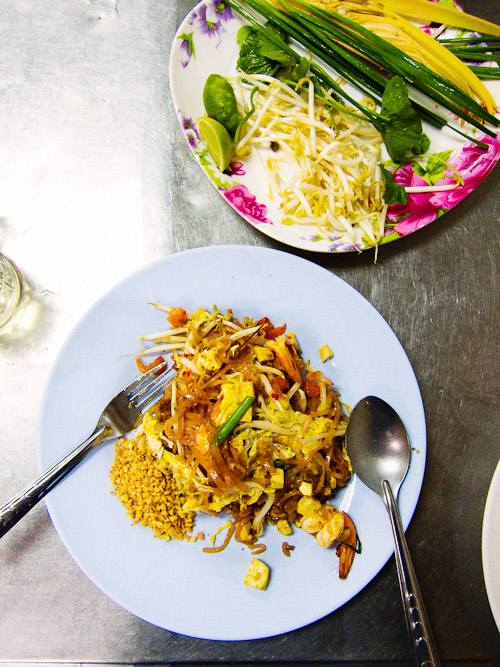 Tipped off by กินรอบกรุง 2 (Kin Rob Krung 2), a Thai-language food guide based on a television programme, I was recently pointed in the direct of Phat Thai Mae Am, a shophouse restaurant specialising in just two dishes: phat Thai and kuaytiaw khua kai.
Tipped off by กินรอบกรุง 2 (Kin Rob Krung 2), a Thai-language food guide based on a television programme, I was recently pointed in the direct of Phat Thai Mae Am, a shophouse restaurant specialising in just two dishes: phat Thai and kuaytiaw khua kai.
It's exactly the kind of cozy, friendly, informal, tidy, longstanding, florescent-lit Thai restaurant I love the most:
And to top it off, Mae Am does what is probably one of the better dishes of phat Thai that I've encountered in Bangkok.
The noodles here are seasoned ahead of time with tamarind paste, palm sugar and fish sauce, giving them a pink colour; it's the old-school way of making phat Thai, I'm told. They're then fried to order in a small wok, one or two dishes at at a time, with no additional seasoning. This contrasts with most places, which tend to season the dish in the wok, sometimes doing several orders in one go.
Mae Am adds lots of crunchy salted radish, good-quality dried shrimp, fresh shrimp, and if you like, squid. She fries the egg on the side, letting the mixture ignite briefly over the charcoal fire before dishing it up:
The result feels almost delicate, and lacks the oily gloopiness of lesser versions of phat Thai - a result of that clever pre-seasoning, I suspect. As is the norm, the dish is served with a small pile of ground peanuts and the usual sides of Chinese chive, bean sprouts, banana flower, lime and pennywort.
Mae Am's kuaytiaw khua kai, wide rice noodles fried with chicken and egg, is also quite good:
It's slightly smokey - again, from that charcoal flame - and well-seasoned. My only gripe with this (and the phat Thai) would be that, unlike the version at Nay Hong, Mae Am uses vegetable oil, not lard, as her fat of choice.
Saturated fat aside, these are two solid reasons to take the MRT to Khlong Toei come mealtime.
Phat Tha Mae Am Th Rama IV, Bangkok 11am-10pm Mon-Fri, 2-10pm Sat & Sun
View Thai Eats in a larger map
Tang Kuang Khi Hiang/ตั้งกวงคี่เฮียง
 Kun chiang (กุนเชียง) is a sweet, dried sausage of Chinese origin. I was never a fan of the stuff, finding it sweet in taste and waxy in texture, until I discovered Tang Kuang Khi Hiang, a shop in Bangkok's Chinatown.
Kun chiang (กุนเชียง) is a sweet, dried sausage of Chinese origin. I was never a fan of the stuff, finding it sweet in taste and waxy in texture, until I discovered Tang Kuang Khi Hiang, a shop in Bangkok's Chinatown.
The third-generation owners here claim to do a Hong Kong-style version of the sausage, which to me seems less sweet, slightly less fatty, and not waxy at all. The standard version is made from pork, but they also do a pork liver version and a duck version.
Kun chiang can be fried and used as a side along with Chinese-style kaeng karii, or as the owner suggested, fried and steamed with chicken and ginger. It's delicious when sliced and thrown into a pot of rice as it steams, or when fried with kai-lan and salt, a dish I had at Yung Kee in Hong Kong. Another popular use for the sausage in Thailand is khao phat kun chiang, rice fried with kun chiang, the video recipe for which can be seen here.
Tang Kuang Khi Hiang 352 Th Yaowarat, Bangkok 02 224 7065 9am-9pm
View Thai Eats in a larger map
24 Hours in Trang
There's not a whole lot to do in Trang, a sleepy town in southern Thailand, but this is made up for by the fact that it may very well be one of the country's best food towns. Seemingly confirming this is fellow blogger and University of Oregon alum Oh Sirin, who has written a guide to the city's restaurants called เขาว่ากันว่าร้านนี้อร่อยที่ ตรัง & ภูเก็ด (rough translation: They Say This Restaurant's Great in Trang & Phuket). Book in hand, I recently spent a huge chunk of my 24 hours in Trang eating at the city's excellent old-school Thai-Chinese, Muslim and southern Thai restaurants and stalls. Photographic evidence of this is below; click the button in the corner for full-screen mode and captions.
View Thai Eats in a larger map
Fish sandwiches in Istanbul
 If I hadn't been reminded of it by a recent post at EatingAsia, this blog probably would have continued sitting in my Out box.
If I hadn't been reminded of it by a recent post at EatingAsia, this blog probably would have continued sitting in my Out box.
I spent fewer than 48 hours in Istanbul, but in this short time got the impression that eating takes a distinctly different form there.
Take, for example, the costume and showmanship associated with serving Turkish-style ice cream:
or tea:
Or the city's alleged signature dish, balık ekmek, a type of fish sandwich, which, of course, isn't just a sandwich, but a show performed on rocking boats:
The boats, which are moored by the foot of the Galata Bridge on Istanbul's European side, are floating kitchens where men griddle fillets of a mackerel-like fish and serve them in sandwiches. You pay on the pier and when the wave is right, the sandwich is handed over:
Served in a spongy roll with a bit of lettuce and onion, and seasoned with little more than salt and lemon juice, I have to admit that my first balık ekmek was, quite frankly, rather underwhelming as a sandwich.
But eaten at the waterfront, with the view of Asia across the way, and the New Mosque as a backdrop:
it seemed to embody that uniquely Istanbul intersection of ceremony and setting, where sometimes taste is only part of the experience.
Fish sandwich vendors Golden Horn, Istanbul
View Thai Eats in a larger map
Khao Karii Nang Loeng/ข้าวกะหรี่นางเลิ้ง
 Kaeng karee (แกงกะหรี่) generally refers to a mild Chinese-style curry served with thin slices of tender pork or crunchy beef tendon. It's not nearly as complex or spicy as a typical Thai curry and is one of only a handful of Thai dishes that include bottled curry powder.
Kaeng karee (แกงกะหรี่) generally refers to a mild Chinese-style curry served with thin slices of tender pork or crunchy beef tendon. It's not nearly as complex or spicy as a typical Thai curry and is one of only a handful of Thai dishes that include bottled curry powder.
Ideal Map's Good Eats Rattanakosin map (see details here) led me to this open-air shophouse near Nang Loeng Market that turned out to do one of the better plates of kaeng karee I've come across in Bangkok.
The kaeng karee muu, pork curry (pictured above,) here is spicier than average, but as is the standard, comes served with slices of deep-fried kun chiang, Chinese-style pork sausage, a few slices of cucumber and sliced chilies.
They also do a similar satoo lin muu, a stew of pork tongue, served the same way.
For more places to eat kaeng karii, including a couple places that do the similarly-named but Muslim-influenced dish, check out this article I did for CNNGo.
Khao Karii Nang Loeng Th Suphaminit, Bangkok 02 282 3918 8am-2pm
View Thai Eats in a larger map
Save the date
If you're in New York City, that is. On October 5, Australian chef David Thompson will be doing a one-off khanom jeen dinner at Betel, featuring a little help from some of the guys at Portland's Pok Pok:

Suki Haeng Saphan Leuang/สุกี้แห้งสะพานเหลือง
 I'm working on yet another piece about obscure Thai dishes for CNNGo's Bangkok pages. This week I'm eating suki haeng (สุกี้แห้ง), the wok-fried 'dry' version of the ubiquitous do-it-yourself hotpot sukiyaki that's found in just about every shopping centre in Thailand.
I'm working on yet another piece about obscure Thai dishes for CNNGo's Bangkok pages. This week I'm eating suki haeng (สุกี้แห้ง), the wok-fried 'dry' version of the ubiquitous do-it-yourself hotpot sukiyaki that's found in just about every shopping centre in Thailand.
Of the handful of suki haeng restaurants I've been to so far, a list that includes the famous Elvis Suki, this tiny stall at the side of Thanon Rama IV stands out as my favourite. The proprietor claims to have been making the dish at this location for at least 30 years, and in this time he's arrived at the combination of flavours and textures that define an excellent version of the dish.
A pork or chicken order here comes with tender, marinated meat, while the seafood version includes squid and shrimp. A dish here is slightly smokey with some nice charred bits, and contains lots of vegetables and egg and a relative minimum of noodles. A squirt of oyster sauce provides the suki with a bit more meaty roundness, and his dipping sauce - the element that can make or break a good suki - is excellent, combining meaty and spicy flavours with lots of garlic.
It's a very simple dish, as this video illustrates:
He begins by heating oil over a high flame, adding to it egg and protein. These are just barely cooked before he adds the veggies (a combination of Napa cabbage, green onions and morning glory), a knot of bean thread, a pinch of sugar and MSG, and a squirt of oyster sauce. A few more turns to bring it all together and the dish is done in less than a minute.
It'd be an easy Thai dish to make at home, the only thing lacking being the nam jim suki (น้ำจิ้มสุกี้), the dipping sauce, which as this video (in Thai only) shows, is a much more complicated dish than I'd realised:
If you can't understand Thai but want to have a go at making the dipping sauce it yourself, the process is pretty self-explanatory, and the ingredients include, in the order she introduces them, water, bottled chili sauce, cilantro/coriander root, garlic, fresh chili, sugar, fish sauce, sesame oil, oyster sauce, salt, lime juice and roasted sesame.
Suki Haeng Saphan Leuang Thanon Rama IV, Bangkok 5-10pm
View Thai Eats in a larger map
Jib Kee/จิ๊บกี่
 The area around Bangkok's Nang Loeng Market is home to lots of old-school restaurants that are ripe for investigation.
The area around Bangkok's Nang Loeng Market is home to lots of old-school restaurants that are ripe for investigation.
One of the oldest-school looking ones is Jib Kee, a restaurant that, for more than 50 years, has specialised in meaty Chinese-Thai dishes such as roast pork and duck:
On my first visit I tried their muu krob (หมูกรอบ; shown at the top of this post), roast pork belly, and immediately suspected that it might be one of the best I've encountered in Bangkok. The skin is crispy, without being too much so; the fatty bits literally melt away in your mouth; and amazingly, the meat is moist, tender and even perhaps a bit rare - surely an indicator of restraint and skill on their part. The dish is served with a dipping sauce that combines sliced chillies, dark soy and I think, a bit of vinegar.
The remainder of the restaurant's dishes revolve around duck, and include a decent pet tun (เป็ดตุ๋น), a slightly peppery broth of duck:
roast duck (เป็ดย่าง):
served over bitter greens in a light five spice-based sauce; and duck intestines (ใส้แก้ว):
the latter with little or no flavour of their own, but with a crunchy texture, and served in a slightly salty sauce that included fermented soybeans.
The duck dishes are probably above average, and I suspect they're what attract the high-ranking military generals who frequent the place every time I've been there (a sure-fire sign of a good restaurant in Thailand), but it's the pork belly that would draw me back here.
Here's a video from the Thai television programme, Aroy Rim Thaang ("Delicious Street Food") about Jib Kee:
Jib Kee Th Nakhon Sawan, Bangkok 02 281 1283 9am-3pm
View Thai Eats in a larger map
Granja Viader
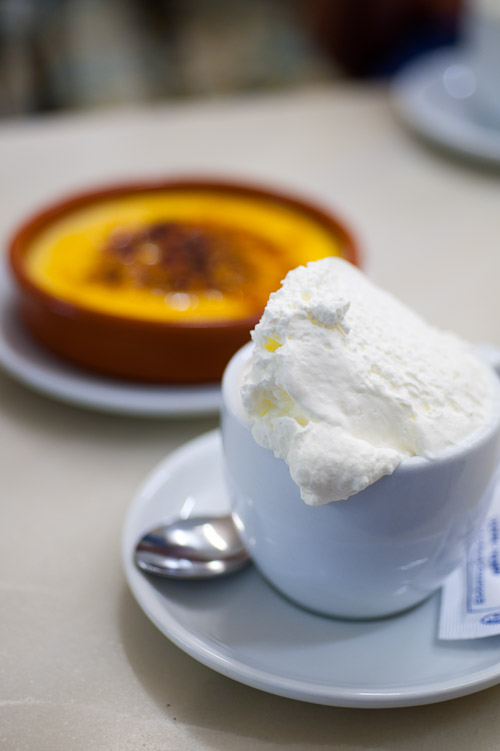 In flipping through photos of my recent trip to Europe, quite possibly one of the most memorable things I consumed there was a cup of Spanish-style hot chocolate at Granja Viader, a more than century old cafe in Barcelona:
In flipping through photos of my recent trip to Europe, quite possibly one of the most memorable things I consumed there was a cup of Spanish-style hot chocolate at Granja Viader, a more than century old cafe in Barcelona:
Luckily the pic at the top of this post does the bulk of the work, because the combination of that fat cloud of whipped cream and the puddle of hot, slightly bitter chocolate is something that can really only be experienced, not explained. In addition to a glass-like crust and a rich texture, the crema catalana had a unique spice flavour that I don't think any of us was able to identify.
Amazing stuff.
Granja Viader C/ Xuclà, 4, Barcelona, Spain 933 183 486












